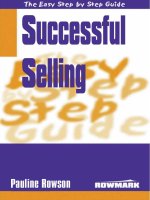Successful selling solution
Bạn đang xem bản rút gọn của tài liệu. Xem và tải ngay bản đầy đủ của tài liệu tại đây (1.1 MB, 258 trang )
Test, monitor and constantly
improve your selling skills
SUCCESSFUL
SELLING
SOLUTIONS
JULIAN
CLAY
“Innovative and
extremely beneficial to
our performance…”
Inside front cover
SUCCESSFUL
SELLING SOLUTIONS
Test, monitor and constantly
improve your selling skills
Julian Clay
Published by Thorogood
10-12 Rivington Street
London EC2A 3DU
Telephone: 020 7749 4748
Fax: 020 7729 6110
Email:
Web: www.thorogood.ws
© Julian Clay 2003
All rights reserved. No part of this
publication may be reproduced, stored in
a retrieval system or transmitted in any
form or by any means, electronic, photocopying, recording or otherwise, without
the prior permission of the publisher.
This book is sold subject to the
condition that it shall not, by way of
trade or otherwise, be lent, re-sold,
hired out or otherwise circulated
without the publisher’s prior consent in
any form of binding or cover other than
in which it is published and without a
similar condition including this
condition being imposed upon the
subsequent purchaser.
No responsibility for loss occasioned to
any person acting or refraining from
action as a result of any material in this
publication can be accepted by the
author or publisher.
A CIP catalogue record for this book is
available from the British Library.
HB: ISBN 1 85418 298 6
PB: ISBN 1 85418 242 0
Designed and typeset by Driftdesign.
Printed in India by Replika Press.
Special discounts for bulk
quantities of Thorogood books
are available to corporations,
institutions, associations and
other organisations. For more
information contact Thorogood
by telephone on 020 7749 4748,
by fax on 020 7729 6110, or
email us:
Acknowledgements
I would like to thank:
•
Doug Dews, a former Sales Operations Manager, for the
benefit of his experience as well as his advice on negotiation and closing a sale
•
Kathleen Canning, a Training Solutions Manager, for her
help on presentations, proposals and ideas regarding the
book’s tables and charts
•
Andrew Mills, a Sales and Marketing Director, for his help
on targeting new companies, managing accounts and
analysing sales performance
•
Martin Clay, an experienced Sales Manager, for his advice
on questioning techniques and in particular, for his help
on the structure and content
•
Lawrie Siteman, a Group Managing Director, for his contribution on preparation, sales development and introductions
to new accounts
•
Mike Brewster, a Sales Consultant, for advising me on the
material used in the example of a proposal and with Ben
Hedger, for incorporating many of the sales models as part
of their daily routine since 2000.
•
The SPIN® strategy – Huthwaite Research Group
•
Winning presentations – The Learning Point Presentations
School
•
The outstanding negotiator – C. H. Godefroy and L Robert
I would like to say a special thank you to the Board Directors,
Area Directors and Training Solutions department of the James
McNaughton Paper Group.
They have given me the opportunity to write and deliver many
sales training and development programmes over the past three
years.
Julian Clay
About the author
Julian Clay has been successful in a sales role for nearly 20
years, first as a sales executive and then as a national account
manager and sales director. In his last year as an account
manager he was the top sales performer in Kodak’s Office
Imaging division in the UK. This gave him an invaluable insight
into what makes sales people successful.
This led him to become a consultant in 1998. His first project
involved finding a solution to common forecasting and account
management issues. He developed sales models that help
companies:
•
Forecast future sales more accurately
•
Develop and manage their accounts well
•
Analyse the strengths and weaknesses of their sales
performance
These have been used successfully by many companies and
tailored to different markets. They enable a sale to be looked at
in an objective way in order to improve performance and make
someone more effective.
In 2001 he became a director of his own company, Sales 2
Success Limited, which also offers personalised sales development and coaching programmes. He has co-written a book
on sales management.
Blank
Contents
About this book
1
Introduction
3
Factors that will affect your level of success
5
Topic reference table
9
Coaching
11
Glossary of sales terms
12
Chapter one
Preparation and sales development
15
Introduction
16
Your products and your competitors
17
Recording sales-call information
21
Forecasting future sales
27
Other sales models
37
Chapter summary
38
Chapter two
Targeting new accounts
41
Introduction
42
Background information on a target account
43
Differentiating yourself from your competitors
47
Written introduction techniques
50
Examples of introductory letters
54
Chapter summary
58
Chapter three
Telephone and personal introductions
61
Key questions
62
Introductory telephone techniques
63
Cold calling on the telephone
66
Overcoming objections on the telephone
70
Common telephone objections
71
Key questions
74
Chapter summary
77
Chapter four
Turning interest into commitment
79
Introduction
80
Questioning and listening
81
Having a structure
88
Advanced questioning techniques
91
Chapter summary
100
Chapter five
Developing a sale correctly
103
Introduction
104
Ensuring that you have ‘genuine’ commitment
105
Presenting the benefits of your solution
113
Other sales development factors
118
Chapter summary
121
Chapter six
The presentation
123
Presentations and demonstrations
125
Preparing presentation material
129
Informal and formal presentations
136
You – the presenter
140
Chapter summary
144
Chapter seven
The sales proposal
147
Introduction
148
Establishing that you are at the proposal stage
149
Difference between quotations, proposals and tenders 151
Structuring a quotation and a proposal
154
Proposal to IT Marketing Limited
162
Chapter summary
170
Chapter eight
Negotiation
173
Introduction
174
Bargaining or negotiation?
175
Setting out your objectives
178
The principles of negotiation
183
Understanding the person you are selling to
187
Chapter summary
192
Chapter nine
Closing the sale
195
Introduction
196
Different types of ‘Close’
197
Buying signals and overcoming objections
200
Good closing techniques
207
Chapter summary
213
Chapter ten
Managing your accounts and
your sales performance
217
Introduction
218
Managing target accounts and relationships
219
Developing an account strategy
224
Gaining an advantage
232
Analysing your sales performance
235
Chapter summary
240
The 10 do’s and don’ts of successful selling
242
About this book
Time Management and Personal Development stands out from
other books in an important way. It is a book to use for your
own self-development.
This guide can be used in several ways. Here are the main possibilities to consider:
•
Individual study. This book is a complete method of selfteaching
•
Workshops and seminars. It can be issued to all participants well in advance of a seminar or course. More time
can then be spent in the seminar exchanging users’ experience and discussing practical applications. The book is also
a workbook that can be given out at the beginning of a
seminar, with participants completing some of the exercises
and checklists as the programme unfolds
•
Distance or open learning. The book can be part of an
organisation’s distance learning strategy, covering those
who, for one reason or another, will not be able to attend
seminars or workshops.
1
Blank
INTRODUCTION
Introduction
‘Successful Selling Solutions’ is aimed at people who have begun
a career in sales as well as those who want to refresh themselves
on some of the main issues. By developing a sale well, you stand
a better chance of gaining genuine commitment and maintaining
good profit margins.
It will also help middle and senior managers to have a better
understanding of the sales process. Although each reader’s
market and level of experience will be different, many of the
disciplines needed, will be the same.
We will introduce sales models to help you in three key areas:
•
Accurate forecasting: To predict future sales and save you
time
•
Account management: To manage relationships/accounts
more effectively
•
Sales performance: To analyse and improve your own
performance
The sales models introduced (in Chapters 1 and 10) will help
you to develop a sale well. They can also be used for coaching
purposes. You will be able to compare your perception with
reality to become more objective at all stages of the sale.
By breaking down the sales cycle into parts and developing
each one well you have more chance of success. This means
4
SUCCESSFUL SELLING SOLUTIONS
that if you have a problem in a particular area, you will be in
a better position to put it right. There are tables of information that you can tailor to your own needs. Most of them contain
‘live’ information to make them easier to interpret.
Progressing a sale well and gaining the right amount of commitment from a buyer will increase your chances of being successful.
This will involve exceeding agreed sales targets which will allow
you to earn commission /bonuses. This is the financial ‘pay off’
for all the hard work that is done in turning a prospect into a
customer.
This book will enable you to develop a structured approach in
order to make you more effective and this will help you to find
your own successful selling solutions!
Factors that will affect your level of success
Today’s selling environment
Changes in the marketplace, economy, communication and
technology have had a big impact in the way companies buy their
products and services. The development of the Internet and
technology generally, has resulted in better communication and
a faster pace at work. Salespeople need to adapt quickly to market
trends, target account needs and expectations. Managing
change remains a challenge to which good salespeople need to
continually adapt.
Developing a sale well
Developing a sale properly makes it easier to focus on the best
opportunities and use of your time. It is achieved by doing the
right things at the right time in the right accounts. It will also
INTRODUCTION
5
involve you thinking of different alternatives to an issue. If one
doesn’t work you will need to think of and implement others.
This will give you a better chance of winning a high proportion of the sales for which you aim.
Your determination to succeed
Desire to succeed, self-motivation and enthusiasm are some of
the qualities that will help you achieve success. Other factors
include patience, being a good listener and having good questioning skills. In the sales process you will make mistakes. Learn from
them so that you minimise/eliminate them in the future.
Good salespeople are assertive, respecting other people’s
views as well as expecting the same in return. You will need
to be pro-active with buyers and creative in your thinking. This
will help you to manage different types of sales situation and
illustrate to a buyer your determination to succeed.
Your selling style
You will need to consider how to develop your own selling style.
By looking at your role and having a good understanding of
your company and market you will increase your chances of
applying your skills well. Your selling style will also affect how
easily you adapt to a sales role.
A partnership approach
With many companies offering the same or similar products
and services, it can be hard for customers to differentiate between
suppliers. Some markets have a longer sales cycle (one year or
more). Developing good business relationships can be a key
factor in winning a sale and growing the account’s potential.
6
SUCCESSFUL SELLING SOLUTIONS
This requires hard work, patience and skill. Having a partnership approach will make it easier to achieve this.
Being objective and taking responsibility
Good sales people look at a situation in an objective way and
take responsibility for their part in managing the sales process.
This maximises the chances of creating a good customer - supplier
relationship.
Managing yourself, your targets and your time well
Being structured, flexible and disciplined will help you to manage
yourself well. You will need to interpret your company’s sales
objectives by meeting/exceeding agreed sales targets and key
performance indicators (K.P.I’s). These should be agreed, easy
to understand, fair and motivational.
There are only a limited number of sales opportunities in a day,
week, month and year. Good time management will help you
to prioritise on what is important to you. This includes deciding
which accounts are worth spending time with and what
business relationships to develop.
Your attitude
Having a positive attitude will help you maintain the right level
of motivation. There are times when selling can be challenging
and frustrating. Someone with a positive attitude who enjoys
selling is more likely to succeed in this type of environment.
Even if there are times when you don’t feel highly motivated,
a positive attitude can help focus your efforts.
INTRODUCTION
7
Interpersonal skills and communication
In a sales role you need to develop good interpersonal skills.
This will make it easier for buyers to relax and enable you to
communicate well with them. Maintaining good eye contact
and paying attention to their body language will help measure
their true level of commitment at each stage of a sale.
Being persuasive
One of the main qualities that good sales people have is their
ability to persuade. This involves:
•
Understanding a target account’s needs and looking for
commitment
•
Building trust when developing your business relationships
•
Making the most of the time you have available
•
Being consistent and determined
•
Reinforcing that your products have value
These points will be easier to achieve if you have good selling
skills and if you develop them. Being persuasive will mean that
buyers will want to buy from you, as well as you wanting to sell
to them!
The following table will enable you to find a personal route
through the book. Topics have been selected that may be of
particular interest to you. You may wish to refer to the chapter
headings for an indication of the topics covered.
8
SUCCESSFUL SELLING SOLUTIONS
Topic reference table
Topic
Chapter
Pages
Managing the
sales issues
1 Preparation and sales
development, (Recording
sales call information)
21
Accurate sales
forecasting and
coaching
1
Preparation and sales
development,
(Forecasting future sales)
27
Gaining maximum
impact when
writing to new
accounts
2
Targeting new accounts,
(Written introduction
techniques)
50
Handling
objections on
the telephone
3
Telephone and personal
introductions,
(Overcoming objections
on the telephone)
70
Ensuring that you
have genuine
commitment
4
Turning interest into
commitment, (Advanced
questioning techniques)
91
Linking your
solution to the
target account’s
need
5
Developing a sale
correctly, (Presenting the
benefits of your solution)
113
INTRODUCTION
9
10
Topic
Chapter
Pages
Presenting the
benefits of your
solution
6
The presentation,
(Informal and formal
presentations)
136
Confirming the
needs/pricing in
writing to a target
account
7
The sales proposal,
(Structuring a quotation
and a proposal)
154
Negotiating a ‘win
– win’ situation
8
Negotiation, (Bargaining
and negotiation)
175
Objection handling
9
Closing the sale, (Buying
signals and overcoming
objections)
200
Managing larger,
more complex
accounts
10 Managing your accounts
and your performance,
(Developing an account
strategy)
224
Monitoring and
developing your
own performance
10 Managing your accounts
and your sales performance, (Analysing your
sales performance)
235
SUCCESSFUL SELLING SOLUTIONS
Coaching
Coaching will help you to develop your selling skills. This can
be done by looking at a sale that you are developing and breaking
it down into a number of key areas, for example:
•
What is the timescale?
•
Who are your competitors?
•
What is the target account’s budget/level of spend?
At the end of a chapter each one of the coaching areas will be
looked at in the form of a table, (see below). A question will be
asked and you will get three possible answers, a negative, neutral
or positive one. Choose the answer that best fits the current
situation in that account. If you are not sure then find out, don’t
guess as this will affect your chances of getting a sale!
Depending on your answer, you will then get coaching advice.
Creating your own model will help you to manage the different
stages of a sale more effectively. This will ensure that you gain
the right level of commitment in a number of areas before you
close for an order.
This table forms part of the forecasting process and ten coaching
areas are covered in more detail in Chapter 2 – Targeting new
accounts, (Developing a sale correctly and Forecasting future
sales).
INTRODUCTION
11
Coaching table
1. Sales areas
2. Status
3. Self-development points
Question?
Negative answer
A
Neutral answer
B
Positive answer
C
Glossary of sales terms
12
SALES TERM
MEANING
Target account
One that you are looking to
do business with/develop a
relationship with
Buyer
Decision-maker and often the
budget holder(at middle/
senior management level)
Senior management
Board director (or in a plc –
senior manager who a budget
holder would report to)
Middle management
Reports to board director/
probably has ‘manager’ in job
title. Probable decision-maker
and budget holder in
middle/large companies
Influencer
Someone who reports to a
middle manager and has no
budget/sole decision-making
responsibility
SUCCESSFUL SELLING SOLUTIONS
Suspect
Someone who doesn’t have a
confirmed need but does buy
your type of product/service
Prospect
Someone who has confirmed
a need and buys your type of
product/service
Customer
Someone who buys your
product/service. Try to
discover the length of the
customer’s buying cycle
Salesperson
Sales executive, account
manager, sales consultant
Sales call
Appointment
‘Would Like’ need
‘Interest’ from a buyer/target
account
‘Must Have’ need
‘Commitment’ from a
buyer/target account
Quote
Short need/price confirmation
Proposal
More detailed need/price
confirmation linking target
account’s needs to your
solution
CRM – Customer
Relationship Management
CRM looks at how companies
can use knowledge about a
target account’s buying trends
and people to communicate
and serve them better. This
will help to maximise growth
and customer retention
INTRODUCTION
13









